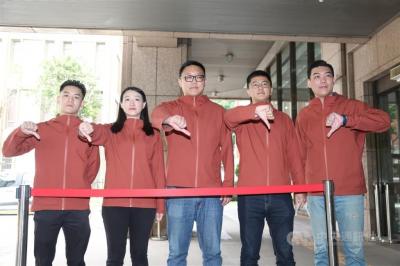When National Chengchi University opened its Center for Prediction Market in March 2006, many were doubtful how accurate its predictions would be.
Four years on, the center has put its name on the map by several times correctly forecasting election outcomes, including the 2008 presidential election. Boasting an accuracy rate of 80 percent to 95 percent, the center is arguably the biggest on-line Chinese-language prediction market.
Prediction markets are speculative exchanges, with the value of an asset meant to reflect the likelihood of a future event. Members can tender virtual bids on events, with the bidding price meant to reflect probability.
Since the University of Iowa established the Iowa Electronic Markets in 1988, prediction markets have boomed.
Many big private companies, such as HP, Yahoo, Microsoft and Google, have set up their own prediction markets to forecast the results of new products, marketing strategies and finances.
Media outlets have also established them, including the CNN Political Market, the Financial Times’ FT PREDICT and the Wall Street Journal’s WSJ Political Market.
The Center for Prediction Market’s Future Events Trading Market, which started operations in July 2006, is open to anyone.
The center’s chief executive, Lin Jih-wen (林繼文), said its predictions were better than opinion polls because traders made their predictions based on objective analysis rather than individual bias.
“Traders earn a profit if their predictions are correct, so the more accurate their forecasts, the more profit they make,” he said.
Prediction centers do better than surveys because poll respondents are randomly picked and might answer dishonestly because they don’t want reveal their positions or are uncertain, he said.
Accurate predictions, however, created problems for the center. Center officials noticed an unusual increase in investors in 2007 before the presidential election, but they didn’t take any action because they thought any futures market could be subject to manipulation, which was not necessarily a bad thing.
It was a problem, however, when it went too far. The center experienced a similar problem during last year’s legislative by-elections. To fix the problem, trading was shut down for more than 10 days, while the center redesigned the registration and trading system.
Despite the new mechanisms, Lin said the center could not guarantee the problem would not happen again.
However, one thing is certain — the center is not facing the problem alone. The Taiwan Political Exchange, the country’s first prediction market, saw a surge of traders in the lead up to the 2008 presidential election.
The Taiwan Political Exchange was established by Academia Sinica’s Institute of Physics in 2003 to gauge the 2004 presidential poll, but it has not been as active as Chengchi University’s center.
Tseng Jie-jun (曾玠郡), a researcher at the Taiwan Political Exchange, said the exchange’s low-key approach was because its purpose was to study trader behavior, not forecast election outcomes.
The exchange also wanted to avoid undue attention and market manipulation, he said.
The center has issued only four contracts since 2003, he said, and they were all on major elections, including the 2008 presidential poll.
With the elections in the five special municipalities set for late November, Tseng said the exchange would launch a promotion campaign three months beforehand to attract traders.
About 300 to 400 participants would be enough to provide good results, Tseng said, while more than 1,000 samples would be allow for in-depth research.
Although participants did not trade in real money, the exchange gives cash rewards to the top 10 traders and publicizes their trading accounts to boost interest in the exchange.
Traders of the Center for Prediction Market use “funny money” in their trades.
Center for Prediction Market director Tung Chen-yuan (童振源) said the center was established for education and research purposes. It had neither the manpower nor the resources to administer trades in real money, and it also didn’t want to cause trouble.
Trouble is the least thing a futures market wants.
The Ireland-based online sports trading exchange TradeSports collapsed in November 2008 because of mistakes it made, including faulty contracts and inaccurate game settlements.
Tung said the Center for Prediction Market makes predictions on various issues, which are classified into eight categories: politics, elections, economy, social affairs, cross-strait affairs, international affairs, entertainment and sports.
As of April, the center had issued 13,437 contracts in its four years of operation, and received more than 214 million trading entries from 121 countries.
Of its participants, 80 percent are from Taiwan, 10 percent from China and rest come from around the world.
Why would people participate in trades and predictions when real money is not involved?
Tung said traders received a sense of achievement. They earned profits in proportion to the quality of information they provided and they could buy and sell at any time based on new information, he said.
The Center for Prediction Market might soon be facing new competition. Media reports say a New Zealand company, iPredict, is planning to venture into Taiwan.
iPredict is New Zealand’s first real money prediction market. Its investors bet on future political, economic, business and social events and the company claims its top traders earned returns of more than 2,000 percent.

Taiwan is stepping up plans to create self-sufficient supply chains for combat drones and increase foreign orders from the US to counter China’s numerical superiority, a defense official said on Saturday. Commenting on condition of anonymity, the official said the nation’s armed forces are in agreement with US Admiral Samuel Paparo’s assessment that Taiwan’s military must be prepared to turn the nation’s waters into a “hellscape” for the Chinese People’s Liberation Army (PLA). Paparo, the commander of the US Indo-Pacific Command, reiterated the concept during a Congressional hearing in Washington on Wednesday. He first coined the term in a security conference last

Prosecutors today declined to say who was questioned regarding alleged forgery on petitions to recall Democratic Progressive Party (DPP) legislators, after Chinese-language media earlier reported that members of the Chinese Nationalist Party (KMT) Youth League were brought in for questioning. The Ministry of Justice Investigation Bureau confirmed that two people had been questioned, but did not disclose any further information about the ongoing investigation. KMT Youth League members Lee Hsiao-liang (李孝亮) and Liu Szu-yin (劉思吟) — who are leading the effort to recall DPP caucus chief executive Rosalia Wu (吳思瑤) and Legislator Wu Pei-yi (吳沛憶) — both posted on Facebook saying: “I

The Ministry of Economic Affairs has fined Taobao NT$1.2 million (US$36,912) for advertisements that exceed its approved business scope, requiring the Chinese e-commerce platform to make corrections in the first half of this year or its license may be revoked. Lawmakers have called for stricter enforcement of Chinese e-commerce platforms and measures to prevent China from laundering its goods through Taiwan in response to US President Donald Trump’s heavy tariffs on China. The Legislative Yuan’s Finance Committee met today to discuss policies to prevent China from dumping goods in Taiwan, inviting government agencies to report. Democratic Progressive Party Legislator Kuo Kuo-wen (郭國文) said

Sung Chien-liang (宋建樑), who led efforts to recall Democratic Progressive Party (DPP) Legislator Lee Kun-cheng (李坤城), was released on bail of NT$80,000 today amid outcry over his decision to wear a Nazi armband to questioning the night before. Sung arrived at the New Taipei District Prosecutors’ Office for questioning in a recall petition forgery case last night wearing a red armband bearing a swastika, carrying a copy of Adolf Hitler’s Mein Kampf and giving a Nazi salute. Sung left the building at 1:15am without the armband and covering the book with his coat. Lee said today that this is a serious